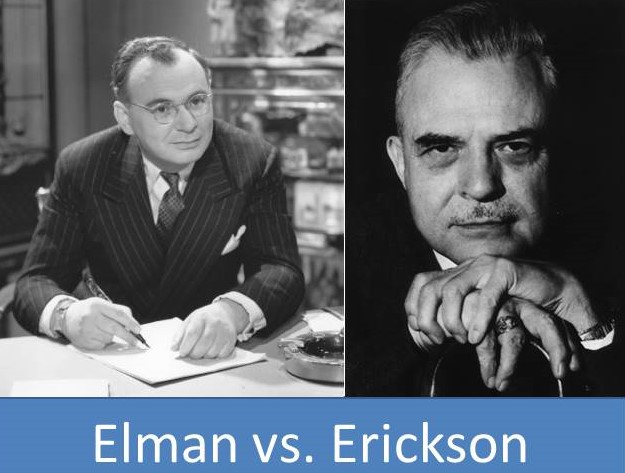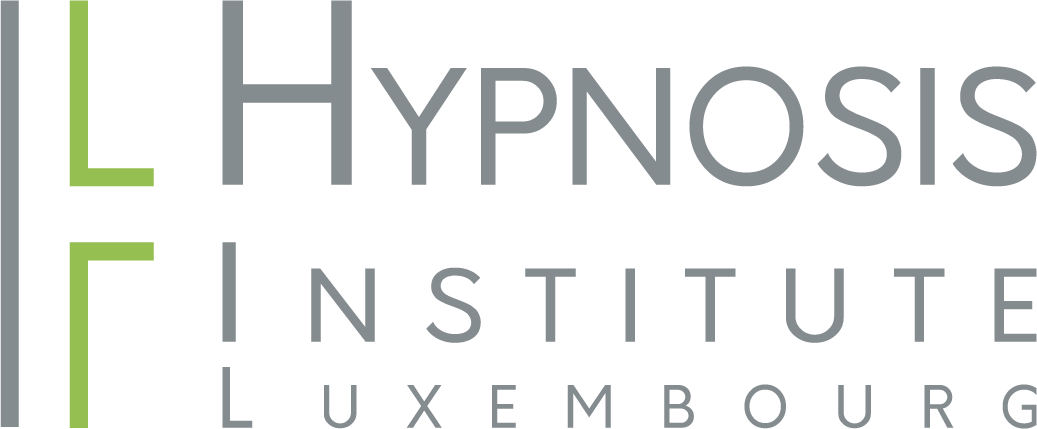Elman v. Erickson

Erickson versus Elman
I would like to share this interesting comparison of two pioneers in modern hypnosis, written by Mike Mandel, with you here. You can see that, in the history of hypnosis, there have always been conflicts of interest and everyone has scratched at a different point on the tip of the iceberg; Even if they did not always agree, it strongly influenced hypnosis as we know it today.
Milton H. Erickson and Dave Elman were definitely two of the best hypnotists of all time. We know that they hated each other and had opposing styles;
So who was the best?
It’s like those old superhero arguments we all had as kids.
Who would win in a fight?
Batman or Superman? …
There are great people in all fields of activity; men and women who reach the pinnacle of excellence. And that includes hypnosis.
Two of the greatest hypnotists of all time.
Milton H. Erickson and Dave Elman
were probably the heavyweights of hypnosis listed on the list of the top ten hypnotists in the history of hypnosis.
Erickson and Elman stand out as truly brilliant because they both changed the field of hypnotherapy.
So, which was the best hypnotist?
Who had the highest level of skill?
In this article we will talk about her methods and what made her really great.
We will address this discussion in terms of what made them different from each other;
By asking ourselves who the best hypnotist was, we completely miss the point.
It’s like comparing a stock car driver to a Formula 1 driver or a marathon runner
to a Sprinter.
We are comparing apples with oranges, and that is something to bear in mind.
Psychiatrist vs. layperson
Milton Erickson and Dave Elman have both brought a wealth of knowledge and wisdom to the field of hypnotherapy.
Erickson was a doctor and psychiatrist; Elman was “only” a layman, but he regularly trained doctors and dentists,
So he had all his credibility with these professionals.
It was their approach that was radically different; Even to the extent of saying that although they never met, they couldn’t stand each other.
Once I heard a recording of Erickson, outraged that Dave Elman had offered to teach him about hypnosis. As I will try to show in this post:
Erickson could have learned a lot from Elman;
And Elman could have learned a lot from Erickson because they were so different from each other;
Speed of work in hypnotherapy
It is important to remember that Milton Erickson’s track record was in psychoanalysis, which came from Freud and his “100 to 300 hours to cure.”
In return, he spent a lot of time preparing his patients to work in deep trance.
Erickson trained his clients, often over several sessions, to experience somnambulism;
to enable the best possible intervention.
Elman, on the other hand, developed very, very quickly. Nevertheless, his work was very long and ecological for the client; In fact, part of Elman’s genius lies in the incredible speed with which
he was able to solve a problem and came to the result.
Whether it’s a phobia, a stutter, post-traumatic stress disorder, whatever, Elman possessed an extraordinary talent for doing a quick job.
If Erickson was a hypnotic strategist on the battlefield, Elman was part of the “trance commandos”.
But there is much more than the speed at which they both worked. There were also differences in style;
Different therapy styles
Dave Elman
Dave Elman was the master of what is called paternal hypnosis.
In this type of work, the hypnotist is extremely directive;
The client is essentially passive while the hypnotist runs the show;
The good thing is that if the hypnotist knows his business (and Elman knew it), the client simply follows the instructions and the hypnotist takes responsibility to bring about change.
With this approach, a highly skilled and directive hypnotherapist can eliminate non-essential elements, address the problem quickly and treat it as a problem to be solved.
Milton Erickson
Erickson, on the other hand, was a maternally skilled hypnotherapist.While Dave Elman would guide the client, Milton Erickson would give him options.
The maternal approach is a softer approach but no less effective. There is less emphasis on “correcting problems” than on mobilizing the client’s unconscious resources.
In his final years, Erickson explained that he was “far too directive” in his early days
Over time, he developed a dialog-oriented approach that was almost impossible to resist.
This is because he used natural trance states as well as lower trance states at the client’s threshold of consciousness.
Activation of the unconscious
Erickson thought the trance was essentially a state of learning, his clients often solved their own problems after meeting him.
This makes sense if we adopt the model that everything we have learned affects every movie we watch;
every conversation we’ve ever had is available as a resource.
Erickson used hypnosis to reconnect his clients with their unconscious
Modern neuroscience recognizes that this type of therapy makes perfect sense because our brains make new connections at an average rate of one million connections per second.
This positions hypnotherapy out of the realm of so-called suggestive power, the placebo effect, or simply belief, into something completely different;
It now appears that hypnosis functions as an amplifier of the human experience
and that the trance states allow us to change things very, very quickly.
So, despite the obvious differences in the methods, the end result is as follows:
These two radically different hypnotists have achieved surprisingly effective results.
Erickson was a researcher who used strange methods;
As a lone researcher, Erickson has earned a place among the greats.
His four volumes, Collected Papers by Milton H. Erickson MD, are part of every hypnotherapist’s library.
The depth of Erickson’s study on the creation and application of trance states is overwhelming.
His methods often seemed to defy reason, for example telling an overweight patient
she had to gain five pounds before she could lose weight.
His “tests” were legendary;
He often told his clients to go out and prune his rose bushes, or climb Squaw Peak, one of the highest points in the Phoenix Mountains, and they did. Despite the strangeness of Erickson’s methods, they have almost always worked;
How did Erickson do all this?
We can say at this point that when we talk about roses, we are no longer talking about hypnosis.
But Milton Erickson would not agree.
Although he produced catalepsy and used time distortion, amnesia and other classic hypnotic phenomena, Erickson worked largely by means of seemingly normal conversation involving metaphor, dissociation, focus shift, etc.
He was indeed the father of conversational hypnosis. As a result, his technique evolved to offer options from which the client could freely choose.
Erickson was an expert at helping clients to access their own abilities in trance;
He developed methods of hypnoanalysis and unconscious learning in which clients essentially solve their own problems;
This indirect and largely intuitive approach made it possible to remove layers of trauma and discover the underlying problems, which were then treated in various ways;
Elman was initially a stage hypnotist
Now we come to Dave Elman, who was extremely directive in his methods;
Having played on the legendary as “the youngest and fastest hypnotist in the world”, he has developed many paternal methods of trance induction.
As Elman continued to teach doctors and dentists, he maintained his rapid inductions and highly directive manner.
Dave Elman’s work has influenced many modern direct hypnotists, and aspects of his methods
can be discovered directly in many modern books.
His unique approach has allowed him to quickly deal with deep-seated issues such as stuttering, trauma, pain reduction, etc…
and also to rediscover the so-called Esdaile State, which had been lost for 100 years.
Wouldn’t it be better just on the basis of speed, exclusively fast inductions
and Dave Elman’s therapy?
Why don’t we stick to a quick and highly directive method;
especially as Elman had an excellent track record?
This type of questioning is at odds with the nature of Erickson’s work.
Erickson and mental illness
Again, it should be noted that Milton Erickson was a psychiatrist with a deep understanding of mental disorders;
His knowledge and interpersonal skills were such that he could literally enter the model of the schizophrenic world.
Once this bridge is built, the wealth of his hypnotic abilities would be applied.
Erickson would bring healing through language by activating the patient’s own unconscious resources;
It should be noted that this type of therapy takes time; It is simply impossible to initiate a quick induction and tell a mentally ill person that their problem has disappeared.
Perhaps this is the reason that very few therapists are able to work as profoundly as Milton Erickson. This type of therapy requires knowledge, experience and proven skills;
Hypnotic continuity
It’s just my opinion, for all the above reasons, when I say it’s neither one or the other, Erickson or Elman.
Each of these geniuses gives us a powerful but different set of tools.
Should we be maternal and indirect, offer opportunities
and activate the unconscious learning mechanism?
Or do we have to be fatherly, point the person concerned to the source of their problem and bring about an immediate change?
In the end, direct hypnosis and indirect hypnosis are a continuity;
With a combination of experience and training, a hypnotist can learn to be as indirect as possible and as direct as necessary;
This kind of behavioral flexibility is what leads to the highest level of competence.
By balancing the incorporation of the client’s unconscious resources with an effective directive approach, an experienced hypnotist can perform an almost unbelievable miracle.
Translated by Alain Wolff. With the kind support of Mike Mandel.
